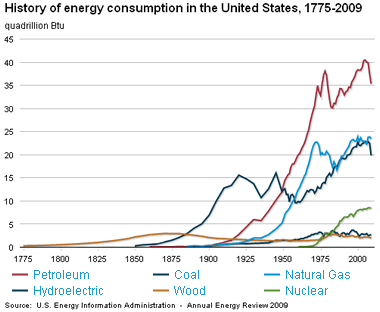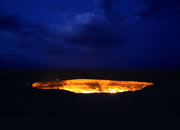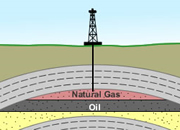Home » Oil and Gas » History of Energy Use in the United States
History of Energy Use in the United States
Article by: Hobart M. King, PhD, RPG

History of energy use: This graph illustrates the history of energy use in the United States between 1775 and 2009. It traces the quantity of energy consumed in the form of wood, coal, petroleum, natural gas, hydroelectric power and nuclear in quadrillions of BTU. This allows the energy sources to be compared on a constant basis. Chart by the United States Energy Information Administration.
A Dynamic Energy Mix
The types of energy used in the United States have changed over time. The change has been driven by advances in technology, energy resource discoveries, energy prices, social pressures and other factors. The only constant is that the amount of energy used has increased steadily over time.
Wood
In the 1700s wood was burned as a fuel in almost every American home and business. It was used for space heating and power generation. Wood was the dominant energy source because it was easy to obtain, portable, and could be consumed on demand.
At this time a significant amount of energy came from animal power. Horses, oxen, mules, donkeys and other animals were used for transportation and power. Water powered mills and machine shops along many small streams and large rivers. Wind was used to run pumps and other simple machines. These forms of energy were abundant, reliable, and renewable.
The use of wood in space heating and power generation grew steadily until the late 1800s when coal assumed its place as the dominant form of energy.
Coal
In the early 1800s some of the first commercial coal mines were operating in several parts of the country. Coal provided more heat per pound than wood and occupied a smaller volume. It was a much more portable fuel. Steadily coal consumption climbed, and in the late 1800s the amount of energy produced from coal exceeded the amount produced from wood.
Industrialization, the use of coal to power machinery, and the use of coal in electric power generation supported a strong demand for coal.
Oil and Natural Gas
In the early 1900s advances in drilling technology made oil and natural gas abundant and available at a cost that could compete with coal. They were cleaner fuels than coal and easier to transport, store, and handle in many applications.
The use of oil and natural gas in the United States grew rapidly. Unlike coal, their use was not significantly damaged during the Great Depression. By the mid-1900s oil and gas were widely used in space heating, electric power generation, and as transportation fuels.
Demand for oil and gas grew rapidly and they each surpassed coal in importance in the mid-1900s.
The oil and gas industry enjoyed steady growth in demand for over 50 years. Then, in the early 1970s, economic downturns and price manipulation attempts by producing nations caused significant interruptions in demand growth. Growth resumed in the late 1970s and continued, almost uninterrupted, until the financial crisis of 2008. At that time demand for oil fell suddenly. However, low natural gas prices and greater availability triggered by hydraulic fracturing in shale allowed natural gas demand to continue with minor interruption.
Nuclear Power
The commercial production of nuclear power began in the 1950s and began to increase rapidly in the early 1970s when a number of nuclear power plants began coming online.
Although the amount of nuclear power produced has grown steadily, events like the Three Mile Island accident (1979) and the Chernobyl accident in Russia (1986) have generated significant social pressures and safety concerns that have throttled the nuclear power potential. Problems related to the secure disposal of nuclear waste materials have been a throttle on the industry.
| Source | Percent Growth 1995 - 2009 | Percent of US Energy Supply in 2009 |
| Hydro | -17.9% | 2.83% |
| Geothermal | 26.9% | 0.39% |
| Solar | 55.7% | 0.12% |
| Wind | 2,012.1% | 0.74% |
| Biomass | 15.9% | 4.12% |
| Total Renewable | 15.9% | 8.20% |
| Data Source: Energy Information Administration | ||
Renewable Energy Sources
Renewable energy currently accounts for about 8.20% of the United States energy consumption. Most of that comes from biomass and hydroelectric sources. Since 1995 the amount of energy produced by renewable sources has increased by 15.9%.
The most rapidly growing renewable energy source since 1995 has been wind power. The implementation of wind power has exploded with an increase of over 2000%. Although this is spectacular growth, wind contributes less than 0.75% of the nation's energy supply.
Solar has grown over 55% since 1995, and the rapid fall in the price of solar panel capacity should support future growth. Geothermal has grown nearly 27%. New technologies and higher fossil fuel prices now make geothermal space heating projects cost competitive with fossil fuel units.
Renewable Energy Future
The future of renewable energy is very bright. The cost per BTU has been falling. Methods of integrating them smoothly into buildings, vehicles and primary energy sources are improving. Climate change fears are motivating governments to support renewable energy projects with grants, tax relief, and other incentives.
Renewable energy projects almost always help the United States to become more energy independent. This is because renewable energy projects are usually located close to where the energy will be consumed. This decreases their environmental impact, decreases costs and gives governments incentives to reduce foreign dependency.
Unconventional Oil and Natural Gas
The energy future of the United States will also likely be heavily influenced by new technologies in the fields of unconventional oil and natural gas. Procedures such as horizontal drilling and hydraulic fracturing have enabled production from low-permeability reservoirs that were unproductive to marginal as recently the late 1990s. The availability of abundant, inexpensive domestic natural gas and oil has been a welcome injection into the United States economy.
| More Oil |
 |
Horizontal Drilling |
 |
Oil and Gas Rights |
 |
Shale Gas Resources |
 |
Gifts That Rock |
 |
What is LNG? |
 |
The Doorway to Hell |
 |
Natural Gas Investing |
 |
Helium |

Find Other Topics on Geology.com:

|

| ||

|

| ||

|

| ||

|

|
